As employee engagement has become an increasingly important metric of business success, some still question: Are employee surveys effective?
The answer is it depends on whether they’re done correctly. Employee survey effectiveness comes down to several factors, most importantly:
- Does the survey have a clear purpose?
- Does the survey ask the right questions, of the right people, at the right time?
- Is there follow-up with actions to address survey responses?
In this article, we’ll present research data that shows just how effective employee engagement surveys can be in improving engagement and business outcomes—when they meet all of the above criteria.
Are employee surveys effective?
When they’re done thoughtfully, with a commitment to action and follow-through, research shows the answer is a resounding yes.
Listening to employees by soliciting their feedback can in and of itself win some slight increases in engagement because everyone appreciates being asked about their opinions. But to be really effective, employee surveys need to go beyond a list of formulaic questions. (Tweet this!)
Defining the purpose for the survey needs to come first, to guide design of the questions. The survey can only provide the insights most important to the individual business if it includes the right questions. Because all businesses are different, the right questions will be different for each; they can be determined through a thoughtful assessment of the company’s objectives, strategies, challenges, and opportunities.
Aside from good survey design, research shows that employee survey effectiveness primarily hinges on one factor: taking action in response to employee feedback.
Think of a close relationship you have with a friend or loved one: How would you feel if you answered all of their questions about how you would like to celebrate your birthday, but then they ignored the information you provided to plan your special day? At first, you probably felt great that they were taking your preferences into account, but that also created higher expectations in your mind, and they ultimately failed to deliver. It probably would have been a better experience if they had never asked in the first place.
Companies are no different, and employees will engage in listening opportunities so long as they believe their voices will be heard and used to take action. There’s really no such thing as survey fatigue; however, inaction fatigue plagues organizations.
Perceptyx surveyed more than 1,500 American employees in a 2020 panel study that demonstrates the value of listening in itself. We found that among employees whose companies surveyed throughout the COVID-19 pandemic, engagement was higher across all four measures: intent to stay, referral behavior, personal accomplishment, and pride in the company, as shown in the graph below.
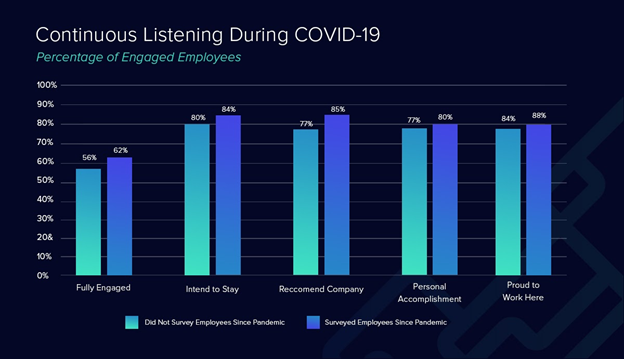
Another recent study by the Josh Bersin Academy demonstrated the value of going beyond simply asking for feedback. The study focused on business resilience and surveyed more than 1,400 organizations about 53 business and HR practices, and correlated them against business outcomes. The researchers then discussed their findings with 160 HR executives from companies around the world to better understand the real-world implications of the research.
The study illustrates the importance of taking action in response to feedback; organizations that both asked and acted had markedly better business outcomes. Researchers found that companies that surveyed through the pandemic and followed up with quick action were more than twice as likely to meet or exceed their financial targets than companies that did not survey. As shown below, companies that surveyed and took action performed better across all the indicators.
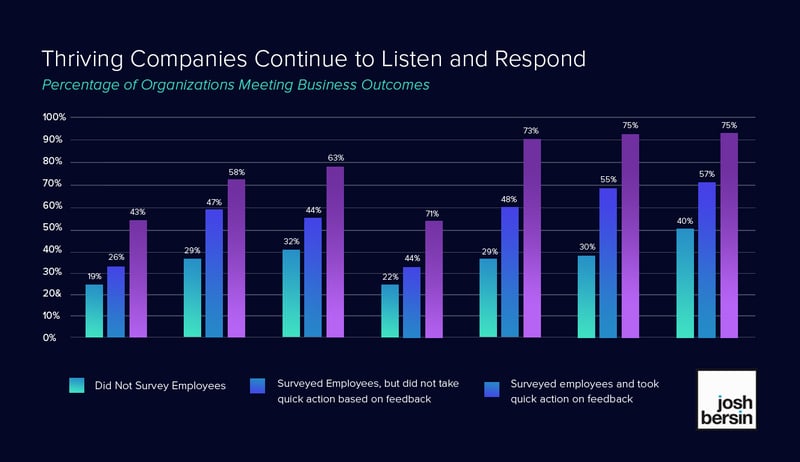
Finally, analysis of data added to the Perceptyx benchmark database over the past three years, drawing on more than 12 million employee responses, reveals the central importance of following up on employee feedback with action. Only 8% of organizations that surveyed but did not follow up with action saw an increase in engagement over a three-year period, whereas 74% of those that did take action realized an increase in engagement. Only 25% of organizations that failed to act on survey feedback scored above the 50th percentile on engagement, while 78% of organizations that took action scored above the 50th percentile.
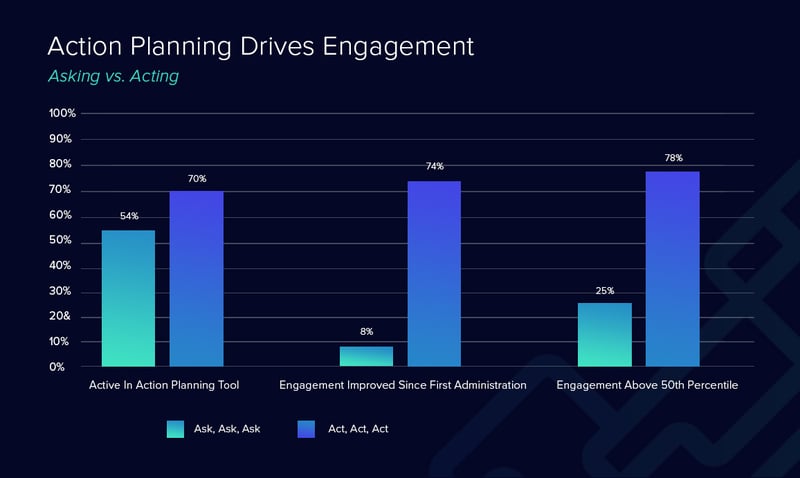
The common thread in all the research is that listening matters—but taking action matters most.
For tips on taking action in response to survey feedback, download the free Perceptyx Insights Brief: If You Ask, Ask, Ask, Then You’d Better Act, Act, Act
If action is the key to employee survey effectiveness, why don’t all organizations act?
There are a variety of reasons why some organizations fail to follow up surveys with action. The organizations surveyed in the Josh Bersin Academy study, for example, were in some cases struggling to deal with the fallout of the pandemic and didn’t feel like they had the bandwidth to take action.
But the biggest reason for failure to take action may stem from difficulties in navigating the action planning process itself. Research by Rotolo, Fleck, and Shepherd in 2020 showed that action planning was the biggest pain point for 52% of organizations surveyed:
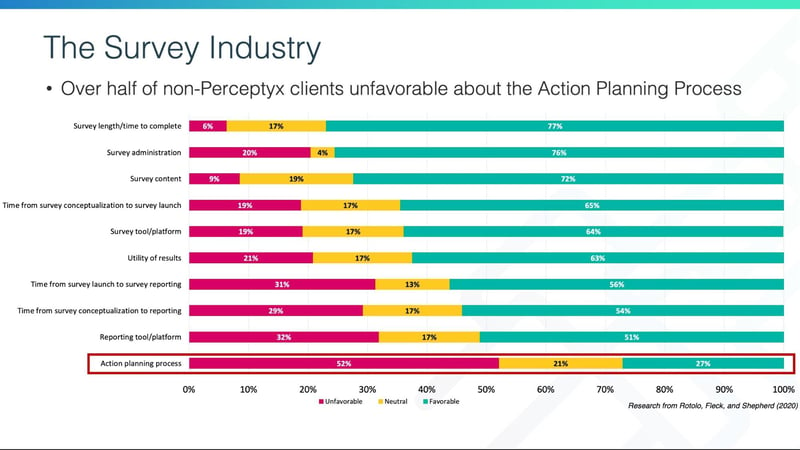
This dissatisfaction with the action planning process often results from a lack of focus. If the organization has predefined what it hopes to achieve by surveying, the areas where it most needs to take action are likely to already be known. But without that focus, the impulse may be to try to “boil the ocean” and attempt to address too many things at one time. This can lead to getting bogged down in the action planning process and never moving beyond it to take action. To this end, don’t let action planning get in the way of action-taking.
Perceptyx has long recognized that action is the key to effective employee engagement surveys, so we’ve developed a simple action-taking platform that can be used in organizations of all types and sizes:
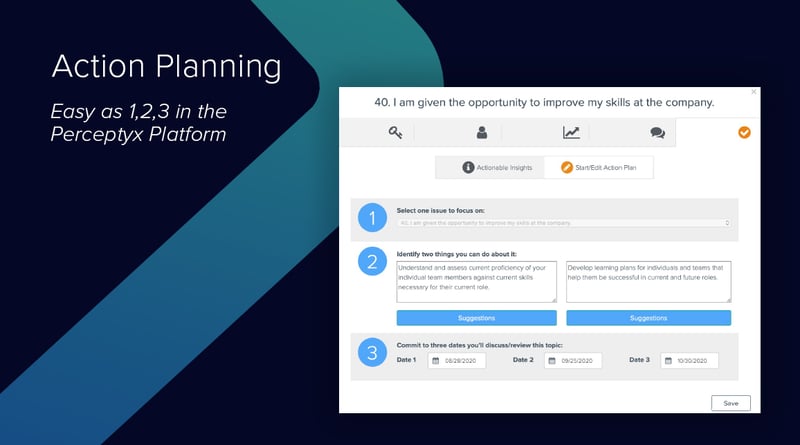
As illustrated above, the 1, 2, 3 action planning model helps organizations and leaders avoid the pitfalls of trying to do too much at once. Instead, the model encourages managers to:
- Focus on addressing one issue.
- Identify two actions to take to address the issue.
- Communicate three times about the issue and actions taken to address it.
By following this model, organizations can avoid getting bogged down in action planning and move quickly to implement actions. The steps in the model can be repeated to address additional issues, one at a time, so it doesn’t limit the actions the organization can take—it simply streamlines the action planning process.
Effective Employee Engagement Surveys Are Connected To Better Business Outcomes
We’ve seen from working with our clients that employee perceptions are connected to the full range of business outcomes. For example, one client, a large, not-for-profit health care system, found that disengaged employees were over two and a half times more likely to leave the organization within the 12 months following the survey than engaged employees. Survey data revealed that a perceived lack of employee recognition was a key driver of voluntary turnover; by taking action to increase employee recognition, the organization can reduce voluntary turnover by 2%, saving at least $10 million annually in turnover costs.
The Josh Bersin Academy research on business resiliency aligns with our findings: Companies that listen and respond to their employees have better business outcomes across the full range of parameters.

So are employee surveys effective? The research shows they absolutely are—if the organization starts with a clear purpose, commits to taking action in response to employee feedback, and follows through.
But far and away, the most important key to effectiveness in your employee survey program—and the key to improving business outcomes—is action. Without action, even the most thoughtfully designed survey will produce only an interesting set of data points; actionable insights can only lead to improvements if they are acted upon.
See the way forward to more effective employee engagement surveys.
The Perceptyx survey platform gives you the flexibility to develop a listening strategy that fits the needs of your organization. Combined with support from our people analytics experts, our platform can help you keep your finger on the pulse of your people’s perceptions, so you can provide the support they need to be the most engaged and productive. Request a demo to see how we can help your organization develop the perfect listening strategy for your needs.

